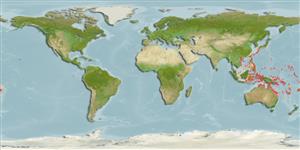>
Ovalentaria/misc (Various families in series Ovalentaria) >
Pomacentridae (Damselfishes) > Pomacentrinae
Etymology: Neopomacentrus: Greek, neos = new + Greek,poma = cover, operculum + Greek,kentron = sting (Ref. 45335).
More on author: Bleeker.
Environment: milieu / climate zone / depth range / distribution range
Οικολογία
Θαλασσινό(ά) Υφαλόφιλο(α); μη μεταναστευτικό(ά); εύρος βάθους 1 - 10 m (Ref. 7247). Tropical
Western Central Pacific: Indonesia, Philippines, Palau, Papua New Guinea, Solomon Islands, and Vanuatu.
Μέγεθος / Βάρος / Age
Maturity: Lm ? range ? - ? cm
Max length : 8.0 cm TL αρσενικό/απροσδιόριστο; (Ref. 9710)
Short description
Κλείδες προσδιορισμού | Μορφολογία | Μορφομετρία
Ραχιαίες άκανθες (συνολικά) : 13; Μαλακές ραχιαίες ακτίνες (συνολικά) : 11 - 12; Εδρικές άκανθες: 2; Μαλακές εδρικές ακτίνες: 11 - 12.
Adults inhabit lagoon and inshore coral reefs, usually in areas where silting is prevalent. Aggregates over coral outcrops to feed on zooplankton (Ref. 1602). Oviparous, distinct pairing during breeding (Ref. 205). Eggs are demersal and adhere to the substrate (Ref. 205). Males guard and aerate the eggs (Ref. 205). Diurnal species (Ref. 54980; 113699).
Life cycle and mating behavior
Γεννητική Ωρίμανση | Αναπαραγωγή | Γεννοβολία | Αβγά | Γονιμότητα | Προνύμφες
Oviparous, distinct pairing during breeding (Ref. 205). Eggs are demersal and adhere to the substrate (Ref. 205). Males guard and aerate the eggs (Ref. 205).
Allen, G.R., 1991. Damselfishes of the world. Mergus Publishers, Melle, Germany. 271 p. (Ref. 7247)
IUCN Red List Status (Ref. 130435: Version 2024-1)
Threat to humans
Harmless
Human uses
αλιεία: Εμπορικό(ά); Ενυδρείο: Δημόσια ενυδρεία
FAO -
